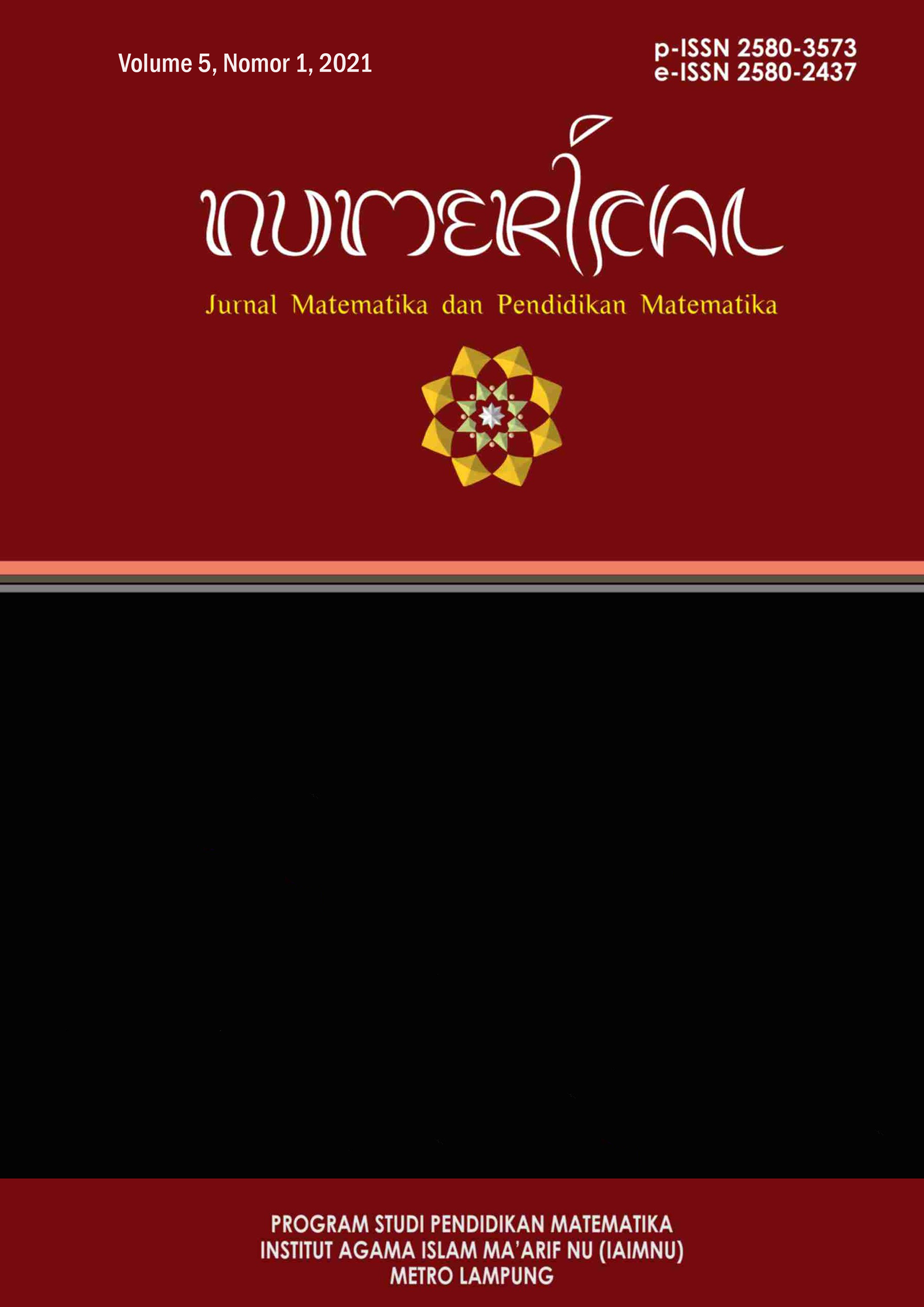Analysis of Learning Quality through Video-Based eLMA Learning in Department Mathematics of Education
DOI:
https://doi.org/10.25217/numerical.v5i1.1207Keywords:
Learning Quality; Video-Based eLMA LearningAbstract
The use of ICT became important after the government through a circular letter from the Minister of Education and Culture regarding the call for the implementation of online learning to prevent the transmission of Covid-19. Each educational institution including Universities PGRI Madiun (UNIPMA) also issued a policy to conduct online learning in providing educational services. This research is descriptive qualitative because it is used to analyze the quality of learning in mathematics education study program through video-based eLMA. Data was collected by means of learning evaluation questionnaires and learning observations of basic mathematics studies, introduction to education, field geometry, and numerical methods. The Data analysis was carried out by reducing, presenting and drawing conclusions about the quality of learning in mathematics education study programs through video-based eLMA. The results of the study quality research showed that the results of the learning evaluation conducted by 4 lecturers who were in charge of basic mathematics studies, introduction to education, field geometry, and numerical methods were categorized as very good with successive scores of 3.65; 3.74; 3.64 and 3.68. The results of the observations of the internal quality assurance team also stated that the learning quality of the four courses was included in good criteria with recommendations maintained.
References
Y. Yuliati and D. S. Saputra, “Pembelajaran Sains Di Era Revolusi Industri 4.0,” Jurnal Cakrawala Pendas, vol. 5, no. 2, pp. 167–171, 2019, doi: 10.31949/jcp.v5i2.1389.
Uswatun Khasanah and Herina, “Membangun Karakter Siswa Melalui Literasi Digital Dalam Menghadapi Pendidikan Abad 21 (Revolusi Industri 4.0),” Prosiding Seminar Nasional Pendidikan Program Pascasarjana Universitas Pgri Palembang, vol. 21, pp. 999–1015, 2019.
U. J. Bora and M. Ahmed, “E-Learning using Cloud Computing,” International Journal of Science and Modern Engineering (IJISME), vol. 1, no. 2, pp. 9–13, 2013.
I. P. G. Sutrisna, “Gerakan Literasi Digital Pada Masa Pandemi Covid-19,” Stilistika: Jurnal Pendidikan Bahasa dan Seni, vol. 8, no. 2, pp. 268–283, 2020, doi: 10.5281/zenodo.3884420.
Kemendikbud RI, “Pedoman Penyelenggaraan Belajar dari Rumah,” 2020.
N. Hamdanillah, A. Harjono, and S. Susilawati, “Pengaruh Model Pembelajaran Advance Organizer Menggunakan Video Pembelajaran Terhadap Hasil Belajar Fisika Peserta Didik Kelas Xi,” Jurnal Pendidikan Fisika dan Teknologi, vol. 3, no. 2, p. 119, 2017, doi: 10.29303/jpft.v3i2.358.
R. P. Dewantara, “Pengembangan Media Video Pembelajaran Tentang Model Pembelajaran Mind Mapping Sebagai Bahan Ajar Mahasiswa,” pp. 621–630, 2011.
I. Oktaviana, S. Sumitro, and U. Lestari, “Pengembangan Bahan Ajar Berbasis Penelitian Karakterisasi Protein Membran Sperma Pada Matakuliah Bioteknologi,” Jurnal Florea, vol. 2, no. 2, pp. 33–42, 2016, doi: 10.13989/j.cnki.0517-6611.2015.10.011.
C. Choirudin, E. F. Ningsih, H. Amrulloh, M. S. Anwar, I. N. Azizah, and M. S. Prastika, “Development of Learning Media for Ethnomathematics and Culture of Lampung with the Powtoon Application,” 1, vol. 3, no. 2, pp. 141–152, Nov. 2020, doi: 10.21274/jtm.2020.3.2.141-152.
N. Supriadi, “Mengembangkan Kemampuan Koneksi Matematis Melalui Buku Ajar Elektronik Interaktif (Baei) Yang Terintegrasi Nilai-Nilai Keislaman,” Al-Jabar, vol. 6, no. 1, pp. 1–15, 2015.
S. Siagian, P. N. J. M. Sinambela, and Y. Wau, “Development of an interactive e-learning model for an instructional design course,” World Transactions on Engineering and Technology Education, vol. 15, no. 3, pp. 298–304, 2017.
R. Y. Purwoko, “Urgensi Pedagogical Content Knowledge dalam Meningkatkan Kualitas Pembelajaran Matematika,” Jurnal Pendidikan Surya Edukasi (JPSE), vol. 3, no. 2, pp. 42–55, 2017.
W. Murtafiah, Suwarno, and N. D. S. Lestari, “Exploring The Types of a Material Presentation by Teachers in Mathematics Learning During The Covid-19 Pandemic,” Journal of Physics: Conference Series, vol. 1663, no. 012043, pp. 1–8, 2020, doi: 10.1088/1742-6596/1663/1/012043.
R. P. Yaniawati, “E-Learning to Improve Higher Order Thinking Skills (HOTS) of Students,” Journal of Education and Learning (EduLearn), vol. 7, no. 2, p. 109, 2013, doi: 10.11591/edulearn.v7i2.225.
P. C. M. Carril, M. G. Sanmamed, and N. H. Sellés, “Pedagogical Roles and Competencies of University Teachers Practicing in the E-Learning Environment,” International Review of Research in Open and Distributed Learning Pedagogical, vol. 14, no. 3, pp. 462–487, 2013.
C. G. Ogbonna, N. E. Ibezim, and C. A. Obi, “Synchronous versus asynchronous e-learning in teaching word processing: An experimental approach,” South African Journal of Education, vol. 39, no. 2, pp. 1–15, 2019, doi: 10.15700/saje.v39n2a1383.
M. S. Anwar, C. Choirudin, E. F. Ningsih, T. Dewi, and A. Maseleno, “Developing an Interactive Mathematics Multimedia Learning Based on Ispring Presenter in Increasing Students’ Interest in Learning Mathematics,” Al-Jabar: Jurnal Pendidikan Matematika, vol. 10, no. 1, Art. no. 1, Jul. 2019, doi: 10.24042/ajpm.v10i1.4445.
H. D. Surjono, “Membangun Course E-Learning Berbasis Moodle,” Membangun Course e-Learning Berbasis Moodle, pp. 1–66, 2010.
Wardono, “Peningkatan Literasi Matematika Mahasiswa Melalui Pembelajaran Inovatif Realistik E-Learning Edmodo Bermuatan Karakter Cerdas Kreatif Mandiri,” Kreano: Jurnal Matematika Kreatif-Inovatif, vol. 6, no. 1, pp. 95–102, 2015, doi: 10.15294/kreano.v6i1.4978.
M. Miles, M. Huberman, and J. Saldana, Qualitative Data Analysis, vol. 1, no. 1985. 2014. doi: 10.1080/0140528790010406.
R. Diani, Y. Yuberti, and S. Syafitri, “Uji Effect Size Model Pembelajaran Scramble dengan Media Video Terhadap Hasil Belajar Fisika Peserta Didik Kelas X MAN 1 Pesisir Barat,” Jurnal Ilmiah Pendidikan Fisika Al-Biruni, vol. 5, no. 2, p. 265, 2016, doi: 10.24042/jpifalbiruni.v5i2.126.
A. M. Mappalotteng, “Pengembangan Multimedia Video Tutorial Pada Pembelajarn TIK di Sekolah Menengah Pertama,” no. 1, pp. 55–67.







